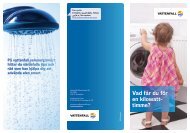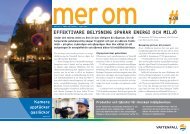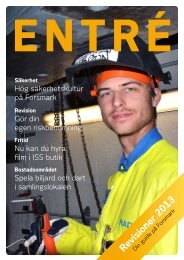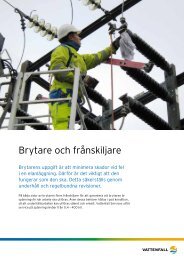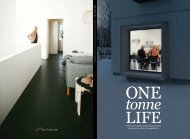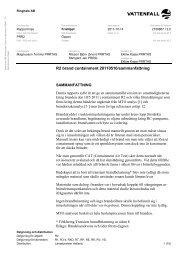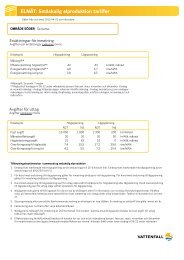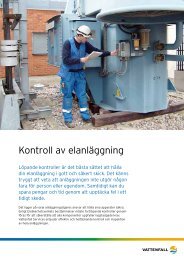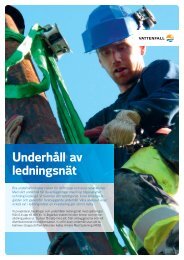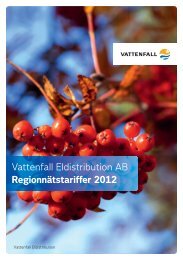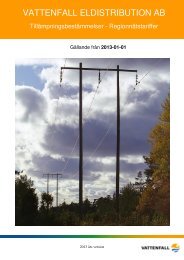This environmental impact assessment for Kriegers flak ... - Vattenfall
This environmental impact assessment for Kriegers flak ... - Vattenfall
This environmental impact assessment for Kriegers flak ... - Vattenfall
Create successful ePaper yourself
Turn your PDF publications into a flip-book with our unique Google optimized e-Paper software.
The average occurrence of Þ sh was measured to 122<br />
individuals/hectare and 13.8kg/hectare.<br />
The test Þ shing of cod has mainly resulted in detection<br />
of a stock of between 18 and 23 cm, see Þ gure<br />
below. Juvenile cod under 15 cm was sparse, only 3.5<br />
% of the catch. Spawn mature cod above the minimum<br />
size of 38 cm only accounted <strong>for</strong> 4.7 % of the catch.<br />
The result of these tests in other words indicated<br />
that the area does not constitute a spawn or growth<br />
area <strong>for</strong> cod.<br />
The survey methods from the test Þ shing in the<br />
spring of 2004 have been assessed and suggestions <strong>for</strong><br />
further test Þ shing in the autumn of 2004 and spring of<br />
2005 have been worked out. The result of these complimentary<br />
tests will be presented in March 2005.<br />
FISH IN THE BALTIC<br />
The fi sh fauna in theBaltic can be divided into two<br />
categories, namely those who prefer to live in pelagic<br />
areas and those who prefer benthic conditions (i.e.<br />
species living close to the seabed). Examples of pelagic<br />
species are herring, Clupea harengus, spratt, Sprattus<br />
sprattus, salmon, Salmo salar, brown trout, Salmo<br />
trutta, transparent goby, Aphia salar and mackerel,<br />
Scomber scombrus.<br />
Those who prefer the seabed are cod, Gadus<br />
morthua and whitling, Merlangius merlangus. These<br />
species hunt either directly on the seabed or just<br />
above it. The cod prefers to stay at mussel banks,<br />
areas covered in growth and stony areas.<br />
Smaller fi sh belonging to the goby species live on<br />
sandy seabeds, <strong>for</strong> instance grey gunard, Ammodytidae,<br />
Eutrigla gurnardus, and young fl at fi sh (fl ounder,<br />
Platichthys fl esus, dab, Limanda limanda, plaice, Pleuronectes<br />
platessa and turbot, Psetta maxima).<br />
Rock and stone areas and mussel banks seem to<br />
be favoured by tadpole fi sh, Raniceps raninus, black<br />
goby, Gobius niger, rock gunnel, Pholis gunnellus,<br />
Goldsinny-wrasse, Ctenolabrus rupestris, lumpsucker,<br />
Cyclopterus lumpus, eel, Anguilla anguilla, Viviparous<br />
blenny, Zoarces viviparous, lemon sole, Myxocephalus<br />
scorpius, Fourhorn sculpin, Myxocephalus quadricornis<br />
PRESENTATION OF THE AREA 83<br />
Size distribution <strong>for</strong> cod, spring 2004<br />
and longspined bullhead, Taurulus bubalis.<br />
In shallow waters between the stone fi elds, there<br />
are areas covered with sea grass and algae. In the sea<br />
grass one fi nds broad-nosed pipefi sh (Syngnathus<br />
typhle), greater and smaller pipefi sh and two-spotted<br />
goby (Gobiusculus fl avescens). As these areas are full<br />
of hiding places, they are like playing rooms <strong>for</strong> many<br />
fi sh species.<br />
As the water is relatively deep at <strong>Kriegers</strong> Flak, there<br />
are only very few individuals of red algae fastened to<br />
stones or in aggregate with blue mussels.<br />
On soft seabeds one fi nds Lumpenus lampretae<strong>for</strong>mis,<br />
Rhinonemus cimbrius, Agonus cataphractus<br />
and different kinds of fl at fi sh.<br />
Different species live at different depths. There are<br />
species that move between different depths dependent<br />
on the season.<br />
Fourbeard rockling and Snakeblenny live at more<br />
than 20 metres depth.<br />
Sea stickleback (Spinachia spinachia) live at less than<br />
10 metres depth and is not infl uenced by that planned<br />
project.<br />
Great sandeel lives in coastal waters during the<br />
summer months and retreats to deeper waters during<br />
the winter




